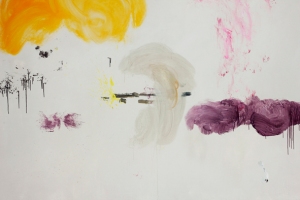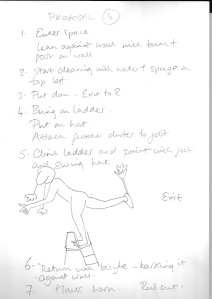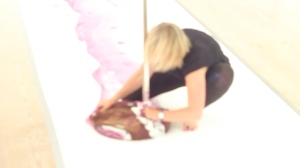
Starting on Valentine’s Day, The Bride and the Bachelors is the ultimate love affair for contemporary artists. Marcel Duchamp taught us to think differently about art. Duchamp, master of the ready-made, gave the western art world the possibility that ‘art’ need not be so distinct from ‘life’. Some of his found objects are on display including the infamous urinal, ‘Fountain’, (1917 and 1950). These works and all of those in the show do not seem to be faded by time. Philip Parreno’s orchestration, which weaves in and out of the five artists work, brings the work alive without detracting from the main artists of the exhibition. A conversation takes place between the 1950’s artists who sometimes consciously referred to Duchamp’s work and at others with an unconscious synchronicity. John Cage was delighted to discover that his musical compositions based on chance using the I-ching had been preceded half a century earlier by Marcel Duchamp’s Erratum Music in 1913 where for one of the pieces Marcel invented a game with his sisters choosing notes from a hat that should be sung in the order picked. The four later artists conceived many of their creative works through their interactions with each other. Their free sense of play and experimentation brought about many fruitful collaborations and sparked their individual creativity. The exhibition shows some of these collaborations and inter-weavings. For example Merce Cunningham’s dance piece ‘Walk Around Time’ 1973, used Jasper Johns set pieces that themselves were based on Duchamp’s ‘The Large Glass’ . Last year the Barbican hosted a performance of ‘Roratorio’ choreographed in 1983 by Merce with a sound track based on a modern Finnegan’s Wake by John Cage. The performance was conceived in tandem, but choreography and music were developed separately only coming together for the performance. The performance was brilliant. The synchronicity that takes place came about partly by chance, but also I think through the sympathetic chemistry between people who who shared a common root. For this exhibition the shared root was Marcel, in another exhibition it could have been Zen Buddhism or Black Mountain College.
Black Mountain College established in North Carolina ran an unconventional course with students and staff collaborating and putting equal energy into daily existence- farming etc, as to art studies. A phenomenal catalogue of artists passed through it’s doors between 1933 and 1956, including Merce Cunningham, Robert Rauschenberg and John Cage. I envy the creative and philosophical family that was created there at that time. Many of the major artists of the 20th century developed their ground-breaking experiential practice there. Art and life were given equal importance. The art department was led by Josef Albers who had come from the recently closed-down Bauhaus with his wife. The artist Anni Albers created beautiful jewellery made from brass grommets, washers, sink drainers and paperclips. The everyday was a legitimate art material. It was here in 1953 that Robert Rauschenberg devised ‘Automobile Tire Print’. In this piece Robert laid typewriter paper on the ground over which John Cage drove his car with Robert replacing paint as needed in front of the oncoming wheel. The trace is the painting shown in the Barbican exhibition.

My work and philosophy celebrates the everyday. The tasks that are part and parcel of my life as a housewife and mother can generate artworks. ‘Drawing with a Heavy Object’ originated from having to heave a heavy standard lamp across my living room floor. I wanted to record this physical feat and so loaded up the lamp’s marble base with paint and proceeded to push it across a six metre length of paper. I had not seen Robert’s ‘Automobile Tire Print’, but there is a remarkable similarity in our performative paintings.
I appropriate domestic items to paint with. For example a feather duster; hat; bicycle,kitchen scourers.

I also use chance operations. In Proposals 1-4 I set myself a list of tasks to perform. See Instruction list below. The painting is the visual trace made after carrying out the series of actions.

Like the artists featured in this great exhibition I am interested in exploring the interface between art and life.






Brilliant and exciting!